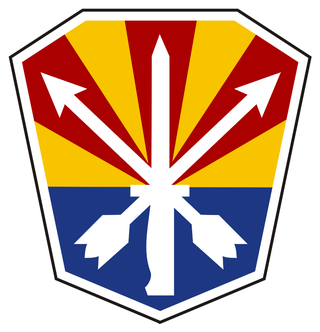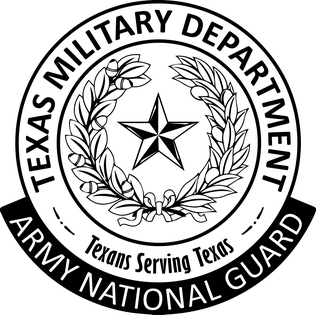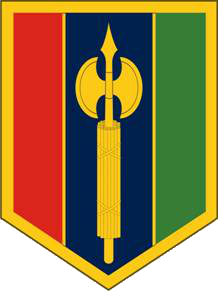Air defense artillery Brigades
- 111th Air Defense Artillery Brigade
Now is the 111th Sustainment Brigade
A shoulder sleeve insignia (SSI) is an embroidered emblem worn on the sleeves of some United States Army uniforms to identify the primary headquarters to which a soldier is assigned. Like division sized units, separate brigades of the U.S. Army are allowed their own SSI to distinguish their wearers from those of other units. Most military units smaller than brigades do not have SSI, but rather wear the SSI of a higher headquarters. The following list of SSIs represent some of the current and former brigades of the U.S. Army:

A brigade is a major tactical military formation that typically comprises three to six battalions plus supporting elements. It is roughly equivalent to an enlarged or reinforced regiment. Two or more brigades may constitute a division.

The Army National Guard (ARNG), in conjunction with the Air National Guard, is an organized militia force and a federal military reserve force of the United States Army. They are simultaneously part of two different organizations: the ARNG of each state, most territories, and the District of Columbia, as well as the federal ARNG, as part of the National Guard as a whole. It is divided into subordinate units stationed in each state or insular area, responsible to their respective governors or other head-of-government.

The 1st Cavalry Division is a combined arms division and is one of the most decorated combat divisions of the United States Army. It is based at Fort Cavazos, Texas. It was formed in 1921 and served during World War II, the Korean War, the Vietnam War, the Persian Gulf War, with the Stabilization Force in Bosnia-Herzegovina, in the Iraq War, in the War in Afghanistan as well as Operation Freedom's Sentinel and Operation Inherent Resolve. As of July 2023, the 1st Cavalry Division is subordinate to III Armored Corps and is commanded by Major General Kevin D. Admiral.

The Eighth Army is a U.S. field army which commands all United States Army forces in South Korea. It is headquartered at the Camp Humphreys in the Anjeong-ri of Pyeongtaek, South Korea. Eighth Army relocated its headquarters from Yongsan to Camp Humphreys in the summer of 2017. It is the only field army in the U.S. Army. It is responsible to United States Forces Korea and United States Army, Pacific.

The United States Army Forces Command (FORSCOM) is the largest United States Army command. It provides expeditionary, regionally engaged, campaign-capable land forces to combatant commanders. Headquartered at Fort Liberty, North Carolina, FORSCOM consists of more than 750,000 active Army, U.S. Army Reserve, and Army National Guard soldiers. FORSCOM was created on 1 July 1973 from the former Continental Army Command (CONARC), who in turn supplanted Army Field Forces and Army Ground Forces.
In the United States Marine Corps, a Marine Air–Ground Task Force is the principal organization for all missions across the range of military operations. MAGTFs are a balanced air–ground, combined arms task organization of Marine Corps forces under a single commander that is structured to accomplish a specific mission. The MAGTF was formalized by the publishing of Marine Corps Order 3120.3 in December 1963, "The Marine Corps in the National Defense, MCDP 1-0". It stated:
A Marine air–ground task force with separate air ground headquarters is normally formed for combat operations and training exercises in which substantial combat forces of both Marine aviation and Marine ground units are included in the task organization of participating Marine forces.

The Arizona Army National Guard is a component of the United States Army and the United States National Guard. National coordination of various state National Guard units are maintained through the National Guard Bureau.

The reorganization plan of the United States Army was implemented from 2006 to 2016 under the direction of the Brigade Modernization Command. This effort formally began in 2006 when General Peter Schoomaker was given the support to move the Army from its Cold War divisional orientation to a full-spectrum capability with fully manned, equipped and trained brigades; this effort was completed by the end of 2016. It has been the most comprehensive reorganization since World War II and included modular combat brigades, support brigades, and command headquarters, as well as rebalancing the active and reserve components.

The Alabama Army National Guard is a component of the United States Army and the United States National Guard. National coordination of various state National Guard units are maintained through the National Guard Bureau.

The Illinois Army National Guard is a component of the United States Army and the United States National Guard. With the Illinois Air National Guard it forms the Illinois National Guard. National coordination of various state National Guard units are maintained through the National Guard Bureau. The Illinois Army National Guard is composed of approximately 10,000 soldiers.

The South Carolina Army National Guard is a component of the United States Army and the United States National Guard. Nationwide, the Army National Guard comprises approximately one half of the U.S. Army's available combat forces and approximately one third of its support organization. National coordination of various state National Guard units is maintained through the National Guard Bureau.

The Texas Army National Guard is a component of the United States Army, the United States National Guard and the Texas Military Forces.
In the United States Army, the term combat support refers to units that provide fire support and operational assistance to combat elements. Combat support units provide specialized support functions to combat units in the following areas

In the United States (US) military, a beret flash is a shield-shaped embroidered cloth that is typically 2.25 in (5.72 cm) tall and 1.875 in (4.76 cm) wide with a semi–circular base that is attached to a stiffener backing of a military beret. These flashes—a British English word for a colorful cloth patch attached to military headgear—are worn over the left eye with the excess cloth of the beret shaped, folded, and pulled over the right ear giving it a distinctive appearance.

The 67th Maneuver Enhancement Brigade is a maneuver enhancement brigade (MEB) of the Nebraska Army National Guard. It derives its lineage from the 67th Infantry Brigade (Mechanized), previously a component of the 35th Infantry Division (Mechanized). The brigade has also been organized as an area support group from 2003–2008, and as a battlefield surveillance brigade from 2008–2016.

A maneuver enhancement brigade (MEB) is a self-contained, modular, and multifunctional support brigade of the United States Army customized to meet whatever mission it receives. A MEB's primary purpose is to plug into operational formations commanded by corps or division commanders, to support brigade combat teams once deployed, and to conduct tactical level tasks and support. MEBs can provide command and control for up to seven battalions that are capable of owning battlespace in combat.

The 302nd Maneuver Enhancement Brigade is a unit of the U.S. Army Reserve based in Massachusetts.

Operation Spartan Shield (OSS) is a USCENTCOM operation in the Middle East. OSS is commanded by United States Army Central and includes units from all service branches. Task Force Spartan is the U.S. Army component of OSS.
Future Soldier is a reform of the British Army resulting from the Integrated Review of Security, Defence, Development and Foreign Policy published in March 2021. The aim of the reform is to create a more lethal, agile and expeditionary force, able to fight and win wars and to operate in the grey-zone between peace and war. Future Soldier was published on 25 November 2021 and deals with the organizational changes of the British Army, with changes to personnel and equipment were set out in the Defence in a Competitive Age paper published on 22 March 2021.